1. Khon Phapheng Falls
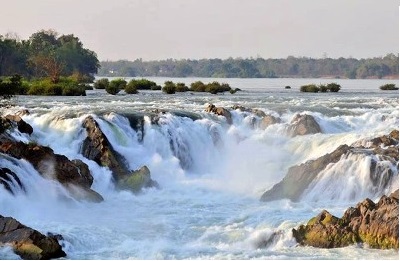
Near the border with Cambodia, the Khon Phapheng Falls (or the "big falls") are the largest in Southeast Asia and they are the main reason that the Mekong is not fully navigable from Cambodia into China.
The highest falls reach to 21 meters, and the succession of rapids stretch 9.7 km of the river's length.
In the late 19th century French colonialists made repeated attempts to navigate the falls but their efforts failed. This difficulty led to the construction of the Don Det / Don Khon narrow gauge railway.
The falls are included in kayak tours out of Don Det and Don Khon. Entrance fee to the Falls is 55.000 kips.
2. Tat Somphamit/ Liphi Waterfalls (Don Khone)
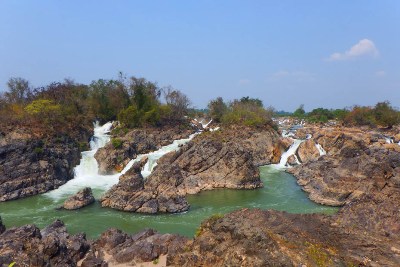
The Liphi waterfall is a collection of powerful falls spilling down at odd angles along a branch of the brown Mekong river. To get there, on foot or by bicycle from BABA guesthouse, just go straight on the main path towards South, following the Mekong, during about 3 km, until the old French Bridge. Cross that bridge, then take the first right immediately after, and follow the signs. If you haven’t paid the admission fee at the bridge you’ll have to pay it here (35.000 kips), but your ticket will be valid for the whole day. A short walk down river from the waterfall is a place called the beach: simply a sandy section of the river, where you can have a dip.
In the dry season it’s a fairly poor swimming spot, but you should have more luck after the side river has filled up a bit. There are more beaches in Don Det and Don Khone to swim in the Mekong.
3. Khon Pa Soi Falls

Although it's not the largest waterfall on the islands, Khon Pa Soi Falls is still pretty impressive, and it never gets crowded due to its isolated location. From the little restaurant (sometimes only serving cold drinks) cross the big, fun (or scary, depending on the person) wooden suspension bridge to Don Po Soi island and follow the roar 200m to the main waterfall.
You can find bathing spots when the river is low, but be seriously careful here and don't get caught in the current.
A second smaller bridge takes you to some of the old logging diversion walls the French built in the Mekong for their logging operations.
4. Tham Phu Khiaw
Cave in Don Khong
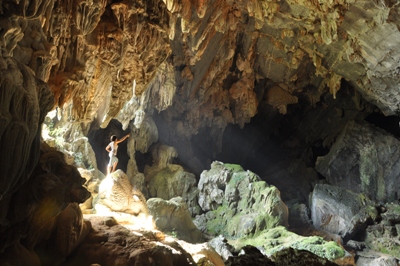
Two kilometres north of Muang Khong a trail leads to Green Mountain Cave, a small, shallow shelter in the middle of the forest. It holds some fairly crude Buddha images and bits of broken pottery and is the object of an annual pilgrimage, usually in June. It's definitely more about the journey than the destination.
It's only a 15-minute walk, mostly uphill. Follow what is clearly the main trail to the second rocky opening in the forest and then veer south (left) to the little cliff. The trailhead is marked by a blue sign. If you wish to continue past the cave to the viewpoint or even all the way across the island, you'll need a guide.
5. Don Khong History Museum
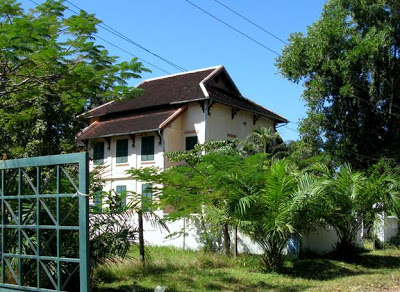
When the local governor built this two-story French colonial-style home in 1935, he was so proud of himself that he christened it Sathanavoudthi, which means 'Garden of Eden' in an old Lao dialect. Level-headed locals just called it 'The Brick House'. In 2010 it was restored and now houses one of Laos' smallest museums. But the musical instruments, animal traps and photos of the Don Khon railway are worth a few minutes of your time. The furniture on the second floor is original.
It is usually kept shut, but go in back and someone will open it for you.
6. Ban Hin Siew Tai Palm Sugar Trees
Farm in Don Khong
Although sugar palms can be seen across the island, Ban Hin Siew Tai is southern Laos' sugar capital. Many farmers here climb the trees twice a day to collect the juice and then boil it down to sugar, and if you see them working you are welcome to pop in for a visit. The sugar season is from November to February and early morning is the best time to go.
7. Wat Jom Thong
Buddhist Temple in Don Khong
At the northern end of Muang Khong is Wat Jom Thong, the oldest temple on the island, dating from the Chao Anou period (1805–28). The wihăhn (temple hall) features a cruciform floor plan, a unique triple-gated entrance, carved wooden doors and shutters, and a bevy of mythical Hindu-Buddhist creatures adorning the roof and gables.
8. Ban Hang Khon Viewpoint
Viewpoint in Don Det & Don Khon
Near the old French port in Ban Hang Khon village, 150 steps take you up to a good viewpoint of the Mekong.
9. Irrawaddy Dolphins
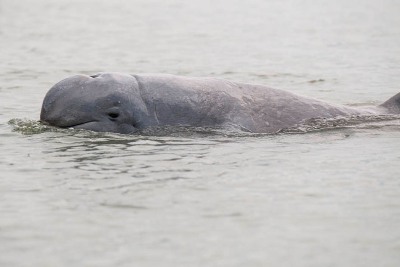
Called Pa Kha in Lao, the one critically endangered pod of Irrawaddy Dolphins in Si Phan Don lives just south of Don Sanlat. Boats can be chartered for one-hour trip from the old French landing pier in Ban Hang Khon (60.000 kips, maximum 3 people), or for one-and-a-half-hour trip from the main beach of Don Khone, after the Liphi falls (90.000 kips, maximum 3 people).
Sightings are regular year-round, but the best viewing is from January to May. Try to go early evening or early morning, when sightings are more regular and the river is at its most scenic.
This Mekong pool lies mostly in Cambodia, which Lao boatmen are reluctant to enter, but you may be able to see them from your boat, or pay a small extra fee (20.000 kips) to the border officials to be allowed entering in a small island that looks over the conservation zone in Cambodian waters. The odds of seeing a dolphin here are quite high. Although they won’t be doing circus acrobatics like those at Sea World, you should see a few ones coming out of the water occasionally as the animals come up for air.
10. Old French Railroad Locomotive

An outdoor display on Don Khon shows a rusted French engine from the late 1800s, when the French built a 7km railroad line to bypass Khone Phapheng falls and create a trade route from Cambodia up the Mekong to Laos and eventually China. The French loaded the boats onto rail cars below the falls then put them back in the water above the falls. The operation was abandoned in 1940 when a road was built around the falls.
Today, you can check out the display and stand on the bridge between Don Det an Don Khon, which was formerly for trains but is now open to foot traffic and two-wheeled vehicles.
 Near the border with Cambodia, the Khon Phapheng Falls (or the "big falls") are the largest in Southeast Asia and they are the main reason that the Mekong is not fully navigable from Cambodia into China.
Near the border with Cambodia, the Khon Phapheng Falls (or the "big falls") are the largest in Southeast Asia and they are the main reason that the Mekong is not fully navigable from Cambodia into China. The Liphi waterfall is a collection of powerful falls spilling down at odd angles along a branch of the brown Mekong river. To get there, on foot or by bicycle from BABA guesthouse, just go straight on the main path towards South, following the Mekong, during about 3 km, until the old French Bridge. Cross that bridge, then take the first right immediately after, and follow the signs. If you haven’t paid the admission fee at the bridge you’ll have to pay it here (35.000 kips), but your ticket will be valid for the whole day. A short walk down river from the waterfall is a place called the beach: simply a sandy section of the river, where you can have a dip.
The Liphi waterfall is a collection of powerful falls spilling down at odd angles along a branch of the brown Mekong river. To get there, on foot or by bicycle from BABA guesthouse, just go straight on the main path towards South, following the Mekong, during about 3 km, until the old French Bridge. Cross that bridge, then take the first right immediately after, and follow the signs. If you haven’t paid the admission fee at the bridge you’ll have to pay it here (35.000 kips), but your ticket will be valid for the whole day. A short walk down river from the waterfall is a place called the beach: simply a sandy section of the river, where you can have a dip. Although it's not the largest waterfall on the islands, Khon Pa Soi Falls is still pretty impressive, and it never gets crowded due to its isolated location. From the little restaurant (sometimes only serving cold drinks) cross the big, fun (or scary, depending on the person) wooden suspension bridge to Don Po Soi island and follow the roar 200m to the main waterfall.
Although it's not the largest waterfall on the islands, Khon Pa Soi Falls is still pretty impressive, and it never gets crowded due to its isolated location. From the little restaurant (sometimes only serving cold drinks) cross the big, fun (or scary, depending on the person) wooden suspension bridge to Don Po Soi island and follow the roar 200m to the main waterfall. Two kilometres north of Muang Khong a trail leads to Green Mountain Cave, a small, shallow shelter in the middle of the forest. It holds some fairly crude Buddha images and bits of broken pottery and is the object of an annual pilgrimage, usually in June. It's definitely more about the journey than the destination.
Two kilometres north of Muang Khong a trail leads to Green Mountain Cave, a small, shallow shelter in the middle of the forest. It holds some fairly crude Buddha images and bits of broken pottery and is the object of an annual pilgrimage, usually in June. It's definitely more about the journey than the destination. When the local governor built this two-story French colonial-style home in 1935, he was so proud of himself that he christened it Sathanavoudthi, which means 'Garden of Eden' in an old Lao dialect. Level-headed locals just called it 'The Brick House'. In 2010 it was restored and now houses one of Laos' smallest museums. But the musical instruments, animal traps and photos of the Don Khon railway are worth a few minutes of your time. The furniture on the second floor is original.
When the local governor built this two-story French colonial-style home in 1935, he was so proud of himself that he christened it Sathanavoudthi, which means 'Garden of Eden' in an old Lao dialect. Level-headed locals just called it 'The Brick House'. In 2010 it was restored and now houses one of Laos' smallest museums. But the musical instruments, animal traps and photos of the Don Khon railway are worth a few minutes of your time. The furniture on the second floor is original. Called Pa Kha in Lao, the one critically endangered pod of Irrawaddy Dolphins in Si Phan Don lives just south of Don Sanlat. Boats can be chartered for one-hour trip from the old French landing pier in Ban Hang Khon (60.000 kips, maximum 3 people), or for one-and-a-half-hour trip from the main beach of Don Khone, after the Liphi falls (90.000 kips, maximum 3 people).
Called Pa Kha in Lao, the one critically endangered pod of Irrawaddy Dolphins in Si Phan Don lives just south of Don Sanlat. Boats can be chartered for one-hour trip from the old French landing pier in Ban Hang Khon (60.000 kips, maximum 3 people), or for one-and-a-half-hour trip from the main beach of Don Khone, after the Liphi falls (90.000 kips, maximum 3 people). An outdoor display on Don Khon shows a rusted French engine from the late 1800s, when the French built a 7km railroad line to bypass Khone Phapheng falls and create a trade route from Cambodia up the Mekong to Laos and eventually China. The French loaded the boats onto rail cars below the falls then put them back in the water above the falls. The operation was abandoned in 1940 when a road was built around the falls.
An outdoor display on Don Khon shows a rusted French engine from the late 1800s, when the French built a 7km railroad line to bypass Khone Phapheng falls and create a trade route from Cambodia up the Mekong to Laos and eventually China. The French loaded the boats onto rail cars below the falls then put them back in the water above the falls. The operation was abandoned in 1940 when a road was built around the falls.